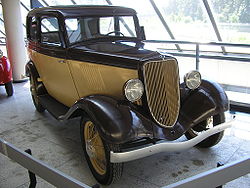Ford Cologne
| ford | |
|---|---|
|
Ford Y (1933)
|
|
| Cologne | |
| Production period: | 1932-1936 |
| Class : | Small car |
| Body versions : | Limousine , panel van , pick-up |
| Engines: |
Otto engine : 0.9 liters (16 kW) |
| Length: | 3630 mm |
| Width: | 1370 mm |
| Height: | 1630 mm |
| Wheelbase : | 2286 mm |
| Empty weight : | 540 kg |
| successor | Ford Eifel |
The Ford Cologne was a car model of the Cologne-based Ford Motor Company Aktiengesellschaft , which was produced from 1932 to 1936. Ford Germany has been building passenger cars in Cologne-Niehl since 1931 , and four-cylinder models from 1933. For marketing reasons , the Ford models produced in the German Reich were given German names from 1933 . This is how the Model Y became the Ford Cologne named after the factory headquarters. The Model Y was specially designed for the European market as a small car. The mobile chassis weighed only 540 kg, with the body it was 700 kg to 750 kg, depending on the version. The four-cylinder engine with 933 cm³ and upright valves developed 16 kW (21 hp) at 3400 rpm and drove the rear wheels via a three-speed gearbox whose second and third gears were synchronized. Both axles were rigid and guided on drawbars and transverse leaf springs. The car reached a top speed of 85 km / h. The car produced by Ford England (as two- / four-door) and by Ford Germany (sedan and convertible) was also sold in Australia (there even as a coupé), in Japan, in Latvia (as "Ford Junior"), in Spain (as "Forito") and made in France (Ford 6 CV).
201,341 models of the Model Y were produced worldwide, 11,121 of them in Germany and 153,117 in England. In the Ford FK 1000 van presented in 1953 , the name Ford Cologne reappeared as an abbreviation; In 1961 the type was renamed Ford Taunus Transit .


